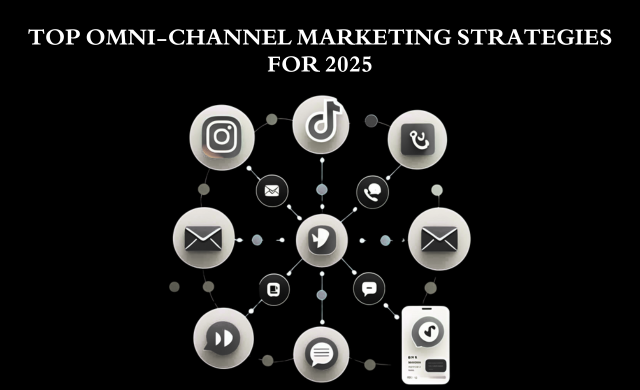Unified or Lost: Why 2025 Is the Year of Smart Omni-Channel Strategy

Let’s be honest—today’s customers don’t shop or interact the way they used to. They bounce around from Instagram to your website, peek at your emails, maybe even drop by your store. And they expect every one of those experiences to feel connected and personal.
If your marketing feels like random one-off messages scattered across platforms, it’s time for a change. Enter omni-channel marketing strategies—a fancy term for making your brand experience smooth, consistent, and personalized no matter where people find you.
And believe me, in 2025, this isn’t optional—it’s table stakes.
What Does “Omni-Channel Marketing Strategies” Really Mean?
In plain English, it means you’re not just shouting your message across different platforms. Instead, you’re creating one story that flows effortlessly across Instagram, email, your website, apps, and even physical stores.
Your customer’s journey is messy—they might see your ad on TikTok, then Google your product, then get an email from you before buying in-store. Your omni-channel marketing strategies tie all those moments together so it feels like one smooth conversation, not a bunch of disconnected shout-outs.
1. Personalized Marketing Is King
Nobody wants to be treated like a number. The biggest win with omni-channel marketing strategies? Being able to deliver marketing that actually feels personal. AI tools can track what people are interested in, then change your messaging on the fly so it fits perfectly.
So if someone checks out your new shoes on your site, they shouldn’t just get generic emails. They should get style tips, restock alerts, or even videos about those exact shoes. That’s how you make customers feel like you really get them.
2. Know Your Customers Everywhere
Here’s the hard truth: If your systems don’t “talk” to each other, your customers will get annoyed. Picture this: a customer signs up on your website, buys something on mobile, and then walks into your store—but your staff have no idea who they are or what they like.
That’s why good omni-channel marketing strategies include tools that track customer data across every touchpoint. When you know who they are and what they want, you avoid sending the same promo twice or missing a chance to help them.
3. Content That Actually Fits Each Channel
Ever see a brand post the same long video on TikTok and LinkedIn? It feels out of place, right? That’s why part of smart omni-channel marketing strategies is reshaping your content for each platform.
Your TikTok video should be punchy and fun, your newsletter more informative, and your in-store materials clear and inviting. The message is the same, but the way it’s delivered feels natural wherever your customers find it.
4. Experience Trumps Price
In 2025, it’s not just about what you sell—it’s about how you make people feel. Great omni-channel marketing strategies focus on delivering an experience that’s smooth and, yes, even enjoyable.
Think chatbots that hand over to a real person seamlessly, or apps that remind customers about deals when they’re near a store. Small details like these turn casual buyers into loyal fans.
5. Automation That Feels Human
I get it—automation sounds cold and impersonal, but that’s not the case anymore. The best omni-channel marketing strategies use automation that adapts to each customer’s needs in real time.
So your email flow might shift if someone just browsed your website, or your chatbot might offer a deal based on what they asked about. It’s like having a personal assistant who knows exactly what your customer wants.
6. Voice, Chat, and The Future
Voice assistants like Alexa aren’t just gadgets anymore—they’re new ways people discover and shop. Smart omni-channel marketing strategies include these voice and chat tools to create more natural, helpful customer journeys.
Imagine a customer finds you by asking Alexa for recommendations, then checks reviews on their phone, and finally picks up the product at your store. That kind of seamless experience is the new normal.
7. Data That Actually Helps You Grow
All these ideas sound great, but if you’re not measuring, you’re guessing. Strong omni-channel marketing strategies rely on solid analytics that show what’s working and what’s not.
By connecting the dots between platforms, you can spot where customers lose interest or what drives sales. That way, you can tweak your approach and spend your marketing dollars wisely.
Where to Begin?
If you’re feeling overwhelmed, you’re not alone. Building effective omni-channel marketing strategies takes the right mix of technology and know-how. But once you get it right, the payoff is huge—more engaged customers, better sales, and a brand that feels connected and caring.
FAQs About Omni-Channel Marketing Strategies
1. Can small businesses really pull this off?
Absolutely! Even small steps like syncing your website, email, and social media can make a big difference.
2. What’s the biggest rookie mistake?
Being everywhere but disconnected. Without connecting the dots, your message gets lost.
3. How does AI fit in?
AI helps make your marketing smarter by personalizing messages and predicting what customers want next.
4. Which platforms are must-haves?
Right now, email, Instagram, TikTok, your website, apps, and voice/chat interfaces are essential.
5. How do I measure success?
Look at customer engagement, repeat business, and conversion paths through integrated analytics.
If you want to win in 2025, it’s time to stop thinking about your channels separately and start mastering omni-channel marketing strategies that truly connect with your customers. The brands that do will be the ones people love—and remember.
